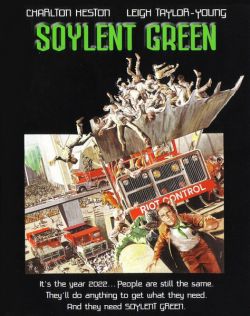 For those who are not privy to nerdy, futuristic dystopian science fiction movies, Soylent Green is a classic. By today’s standards, it’s an awful movie (maybe even by that day’s standards as well). It’s pretty bad. Regardless, the plot is of particular interest here.
For those who are not privy to nerdy, futuristic dystopian science fiction movies, Soylent Green is a classic. By today’s standards, it’s an awful movie (maybe even by that day’s standards as well). It’s pretty bad. Regardless, the plot is of particular interest here.
Released in 1973, the movie portrays a time in the future, specifically the year 2022, when the population of New York City (one slice of the world’s total population at the time) has exploded to a massive 40,000,000 people. Resources are scarce (especially food), poverty is rampant, streets are crowded, and all power has been consolidated into the hands of the government to control the masses of people who are out of control. Because of the lack of food, a company used by the government, Soylent Corporation, produces high-energy ration wafers that the people can consume for nutrition. There is Soylent Red, Soylent Yellow and a new product, Soylent Green. Long story short (here’s a spoiler), Soylent Green turns out to be processed dead people. It’s a sort of secret, government-sponsored recycling program. Yeah gross.
But the larger point of the story, over-population, is what is in view here, because clearly the point of the movie is that if we don’t do something about our exploding populations, this may very well be our future (the whole scaremongering thing, or politics of fear). During the time the movie was made, overpopulation was at the forefront of many intellectual minds, in academia and government. Henry Kissinger, who penned the now infamous National Security Memorandum 200, a formerly classified document detailing America’s approach to third-world nations, described in detail how America might work to reduce the size of those populations (who presented some form of a threat in his mind) through non-violent means (minus abortion of course).
In addition to this, scientists like our current science czar John Holdren, who in 1977 co-authored the science textbook Ecoscience: Population, Resources, Environment, called for “forced abortions, ‘compulsory sterilization,’ and the creation of a ‘Planetary Regime’ that would oversee human population levels and control all natural resources as a means of protecting the planet.” I’m not kidding. Read it here or read about it here. He has not to my knowledge recanted this point of view either … and he’s our science czar. I digress.
Other movies have been used in the past to shape agendas and change the opinions of the masses over the past century. Take the movie The Day After, a made-for-TV movie in 1983 in which a nuclear holocaust occurs the likes of which the world has never seen. Having been made at the height of the Cold War, the big fear this movie stirred up was that the “evil” USSR would obliterate our nation. And the implication as well as the effect of the movie was that we need to take the necessary steps to make sure this never happens. Propaganda? I believe you could safely call it that. Neil Postman describes the philosophy behind this movie in the book Amusing Ourselves to Death. Good read.
So this brings me to the movie Soylent Green. I’m not saying it was propaganda. But what is the best way, in our society, to change social ideas on a mass scale? Make a movie and market it. Think about how much culture has been influenced by the ideas of movies and TV. At the very least it is a reflection of what was being talked about at the time: exploding populations. But by whom, average Americans? Surely not. At the most, it was the actions of intellectuals attempting to shape what they viewed as important.

Leave a Reply